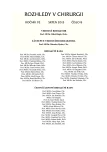-
Medical journals
- Career
Obscure gastrointestinal bleeding
Authors: J. Pastor; S. Adámek
Authors‘ workplace: 3. chirurgická klinika 1. LF UK a FN Motol, přednosta: Prof. MUDr. R. Lischke, PhD.
Published in: Rozhl. Chir., 2013, roč. 92, č. 8, s. 424-428.
Category: Review
Overview
Obscure gastrointestinal bleeding represents 5% of all cases of bleeding into the gastrointestinal tract (GIT). The cause of this type of bleeding cannot be found by gastroscopy or colonoscopy – the most common cause being bleeding from the source in the small intestine. In other cases it is bleeding from other parts of the digestive tube which has already stopped or was not noticed during admission endoscopy. Imaging methods (X-ray, CT, MRI, scintigraphy) and endoscopic methods (flexible or capsule enteroscopy) are used in the diagnosis and treatment. If, despite having used these methods, the source of bleeding is not found and the bleeding continues, or if the source is known but the bleeding cannot be stopped by radiologic or endoscopic intervention, surgical intervention is usually indicated. The article provides an overview of current diagnostic and treatment options, including instructions on how to proceed in these diagnostically difficult situations.
Key words:
bleeding into the GIT – enteroscopy – angiography
Sources
1. Kochhar SG, Sanaka RM, Vargo JJ. Therapeutic management options for patients with obscure gastrointestinal bleeding. Ther Adv Gastroenterol 2012;5 : 71–81.
2. Gerson BL. Recurrent gastrointestinal bleeding after negative upper endoscopy and colonoscopy. Clinical Gastroenterology and hepatology 2009;7 : 828–833.
3. Rondonotti E, et al. The American society for gastrointestinal endoscopy diagnostic algorithm for obscure gastrointestinal bleeding: Eight burning questions from everyday clinical practice. Digestive and liver disease 2012; http://dx.doi.org/10.1016/j.dld. 2012.07.012
4. Heil U, Jung M. The patient with recidivent obscure gastrointestinal bleeding, Best practice and Research clinical gastroenterology. 2007;21 : 393–407.
5. American society for gastrointestinal endoscopy: Obscure gastrointestinal bleeding. Gatrointestinal endoscopy 2005;58 : 650–653.
6. USMLE step 2 – Lecture notes surgery, Ed. 2005–2006.
7. Bresci G. Occult and obscure gastrointestinal bleeding: Causes and diagnostic approach in 2009. World journal of gastrointestinal endoscopy 2009;1 : 3–6.
8. Fried AM, Poulos A, Hatfield DR. The effectiveness of the incidental small bowel series. Radiology 1981;140 : 45–46.
9. Ettore CC, Francioso G, Garribba AP, et al. Helical CT angiography in gastrointestinal bleeding of obscure origin. American journal of roentgenology 1997;168 : 727–731.
10. 1Speake D, Hill J. Obscure bleeding in the gastrointestinal tract. Surgery 2005;23 : 380–382.
11. Voelkel PJ, DiPalma AJ. Deep enteroscopy. South Med J 2010;103 : 1045–1048.
12. May A, Farber M, Aschmoneit I, et al. Prospective multicenter trial comparing push-and-pull enteroscopy with the single - and double-baloon techniques in patients with small-bowel disorders, American journal of gastroenterology 2010;105 : 575–581.
13. Bonnet S, Douard R, Malamut G, Cellier Ch, Wind P. Intraoperative enteroscopy in the management of obscure gastrointestinal bleeding, Digestive and liver disease 2012 http://dx. doi.org/10. 1016/j.did.2012.07.003
14. Pasha SF, Leighton JA, Das A, et al. Double-baloon enteroscopy and capsule endoscopy have coparable diagnostic yield in small-bowel disease: a metaanalysis, Clinical gastroenterology and hepatology 2008;6 : 671–676.
15. Dítě P, et al. Akutní stavy v gastroenterologii, Praha, Galen 2005.
16. Schein M, Rogers NP. Urgentní břišní chirurgie, Praha, Grada 2011.
Labels
Surgery Orthopaedics Trauma surgery
Article was published inPerspectives in Surgery

2013 Issue 8-
All articles in this issue
- Intramural esophageal dissection
- Informed consent
- Right to Privacy
- Lege artis
- Working under supervision
- Obscure gastrointestinal bleeding
- Změny chirurgické techniky při řešení Pectus excavatum v letech 1991–2012
- Compliance with the procedures of modern perioperative care (Enhanced Recovery After Surgery) at surgery departments in the Czech Republic – results of a national survey
- Late failure of the endovascular infrarenal aortic aneurysm solutions - diagnosis and treatment
- Perspectives in Surgery
- Journal archive
- Current issue
- Online only
- About the journal
Most read in this issue- Working under supervision
- Compliance with the procedures of modern perioperative care (Enhanced Recovery After Surgery) at surgery departments in the Czech Republic – results of a national survey
- Informed consent
- Lege artis
Login#ADS_BOTTOM_SCRIPTS#Forgotten passwordEnter the email address that you registered with. We will send you instructions on how to set a new password.
- Career

